|
|
|
| |
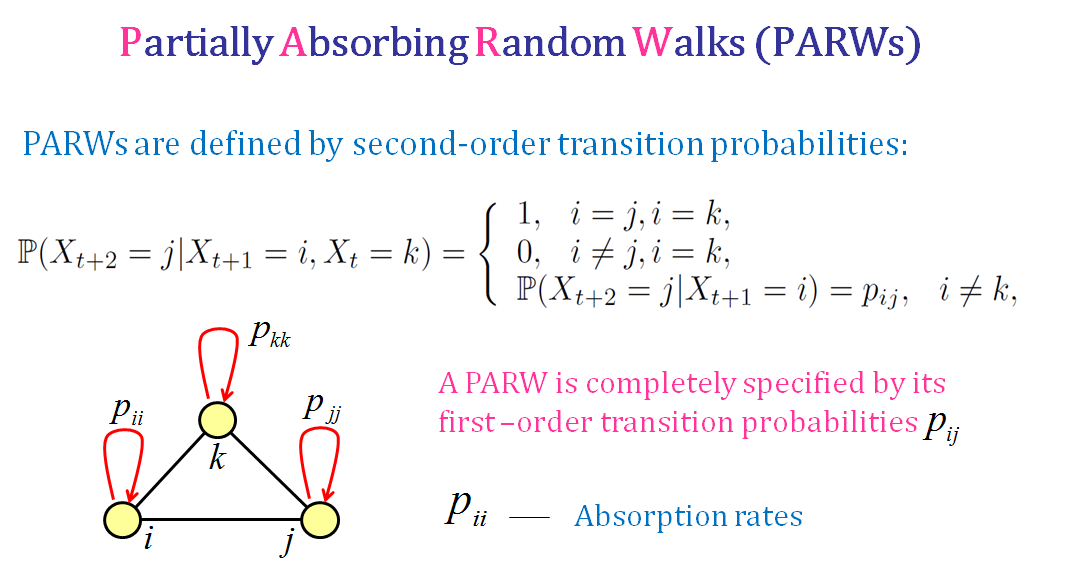 |
|
Learning with Partially Absorbing Random Walks. Xiao-Ming Wu, Zhenguo Li, Anthony Man-Cho So, John Wright, Shih-Fu Chang In Proceedings of Annual Conference on Neural Information Processing Systems (NIPS) Lake Tahoe, NV, USA December, 2012 [pdf] [Supplement] [Poster] |
| |
We propose a novel stochastic process that is with probability $alpha_i$ being absorbed at current state $i$, and with probability $1-alpha_i$ follows a random edge out of it. We analyze its properties and show its potential for exploring graph structures. We prove that under proper absorption rates, a random walk starting from a set $mathcal{S}$ of low conductance will be mostly absorbed in $mathcal{S}$. Moreover, the absorption probabilities vary slowly inside $mathcal{S}$, while dropping sharply outside, thus implementing the desirable cluster assumption for graph-based learning. Remarkably, the partially absorbing process unifies many popular models arising in a variety of contexts, provides new insights into them, and makes it possible for transferring findings from one paradigm to another. Simulation results demonstrate its promising applications in retrieval and classification.
|
|
|
|
|
|
| |
.gif) |
|
Hybrid Social Media Network. Liu, Dong and Ye, Guangnan and Chen, Ching-Ting and Yan, Shuicheng and Chang, Shih-Fu In Proceeding of ACM International Conference on Multimedia (ACM MM) October, 2012 [pdf][slides] |
| |
We develop a hybrid social media network to integrate the diverse types of entities and relations in an optimal selective way for each query adaptively. Rather than weight averaging multiple edges or treating diverse relation types as the same in the inferencing process, we propose an optimal relation selection method based on several sparsity principles. The model not only allows effective information diffusion but also answer the question - which node and relation play the most important role in diffusing information for each query and task. Results of a few applications (image tagging, target multimedia ad, text-to-image illustration) over the real social multimedia data sets confirm the clear performance gains.
|
|
|
|
|
|
| |
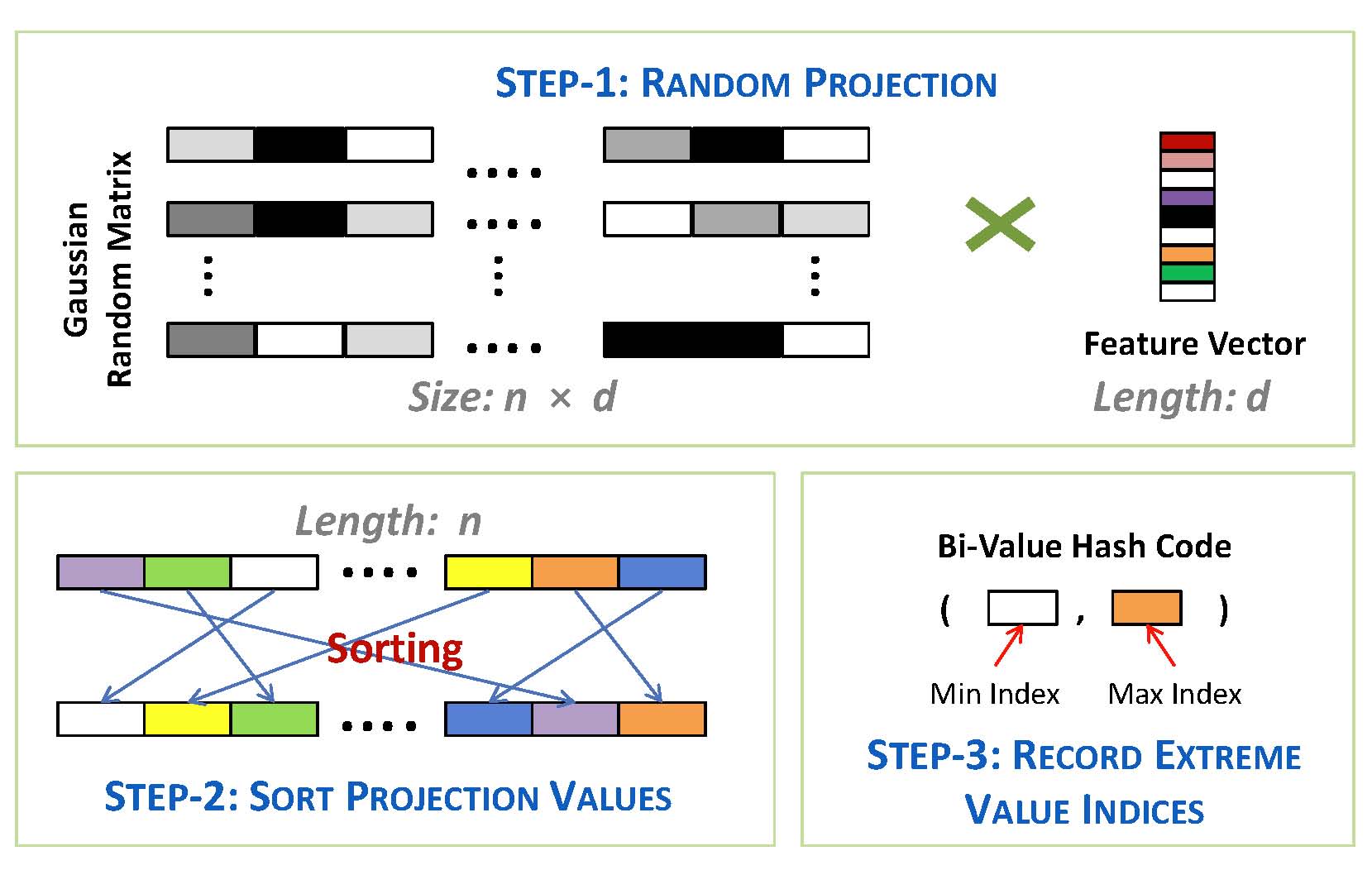 |
|
Accelerated Large Scale Optimization by Concomitant Hashing. Mu, Yadong and Wright, John and Chang, Shih-Fu In European Conference on Computer Vision (ECCV) October, 2012 [pdf] |
| |
In this paper, we propose a brand new application of hashing techniques - accelerating the common bottleneck operation, min/max inner product, encountered in many large-scale optimization algorithms used in applications like active learning SVM, sparse coding, and other computer vision tasks. Our technique is based on some unique properties of order statistics computed from statistically correlated random vectors.
|
|
|
|
|
|
| |
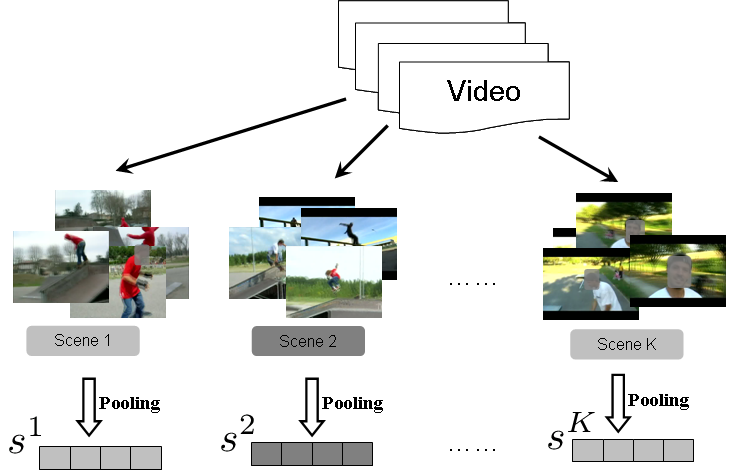 |
|
Scene Aligned Pooling for Complex Video Recognition. Cao, Liangliang and Mu, Yadong and Natsev Apostol and Chang, Shih-Fu and Hua, Gang and Smith, John R. In European Conference on Computer Vision (ECCV) October, 2012 [pdf] |
| |
We develop a new visual representation, called scene aligned pooling, for complex video event recognition. The key idea is to align each frame in a video with component scenes, which tend to capture unique characteristics of an event and can be discovered automatically. Feature pooling and event classification models are then performed over the aligned scenes. Results of TRECVID MED and the Human Motion Recognition Databases (HMDB) demonstrate the significant peroformance gains.
|
|
|
|
|
|
| |
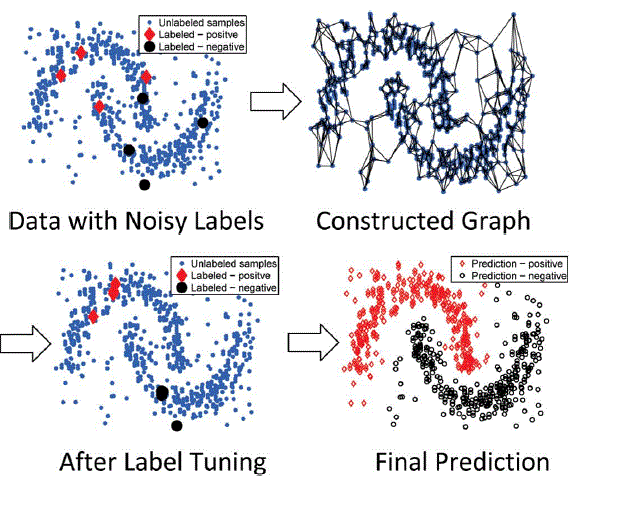 |
|
Robust and Scalable Graph-Based Semisupervised Learning. Liu, Wei and Wang, Jun and Chang, Shih-Fu In Proceedings of the IEEE, vol 100, no 9 September, 2012 [pdf] |
| |
Graph-based semi-supervised learning (GSSL) provides a promising paradigm for modeling the manifold structures that may exist in massive data sources in high-dimensional spaces. This paper provides a survey of several classical GSSL methods and a few promising methods in handling challenging issues often encountered in web-scale applications, including how to handle noisy labels and gigantic data sets.
|
|
|
|
|
|
| |
 |
|
Weak Attributes for Large-Scale Image Retrieval. Felix X. Yu, Rongrong Ji, Ming-Hen Tsai, Guangnan Ye, Shih-Fu Chang In IEEE International Conference on Computer Vision and Pattern Recognition (CVPR) Providence, Rhode Island June, 2012 |
| |
We developed a novel method for retrieving images over a large pool of weak attributes (> 6000), which can be imported from external sources and do not require manual annotations. We used a semi-supervised learning approach to map semantic attribute-based queries to weak attributes and determine the optimal retrieval weights.
|
|
|
|
|
|
| |
 |
|
Robust Visual Domain Adaptation with Low-Rank Reconstruction. I-Hong Jhuo, Dong Liu, D.T. Lee, Shih-Fu Chang In IEEE International Conference on Computer Vision and Pattern Recognition (CVPR) Providence, Rhode Island June, 2012 [pdf][Project Page] |
| |
We present a low-rank reconstruction method to address the domain distribution disparity when adapting image classification models across domains. Besides clear performance improvement, our method has the unique capability in uncovering outlier points that cannot be adapted.
|
|
|
|
|
|
| |
 |
|
Robust Late Fusion with Rank Minimization. Guangnan Ye, Dong Liu, I-Hong Jhuo, Shih-Fu Chang In IEEE International Conference on Computer Vision and Pattern Recognition (CVPR) Providence, Rhode Island June, 2012 [pdf] [Project Page][Poster][Supplementary Material] |
| |
We propose a rank minimization method to fuse the predicted confidence scores of multiple models, each of which is obtained based on a certain kind of feature.
|
|
|
|
|
|
| |
 |
|
Segmentation Using Superpixels: A Bipartite Graph Partitioning Approach. Zhenguo Li, Xiao-Ming Wu, Shih-Fu Chang In IEEE International Conference on Computer Vision and Pattern Recognition (CVPR) Providence, Rhode Island June, 2012 [pdf] [project page] [poster][software] |
| |
We proposed a novel bipartite formulation to integrate superpixels extracted by different models at different scales, and a highly efficient linear-time spectral solver to demonstrate significant better image segmentation results.
|
|
|
|
|
|
| |
.jpg) |
|
Exploiting Web Images for Event Recognition in Consumer Videos: A Multiple Source Domain Adaptation Approach. Lixin Duan, Dong Xu, Shih-Fu Chang In IEEE International Conference on Computer Vision and Pattern Recognition (CVPR) Providence, Rhode Island June, 2012 [pdf] |
| |
We developed a new multiple source domain adaptation method called Domain Selection Machine (DSM) for event recognition in consumer videos by leveraging a large number of loosely labeled web images from different sources such as Flickr. A performance gain of 46% is observed.
|
|
|
|
|
|
| |
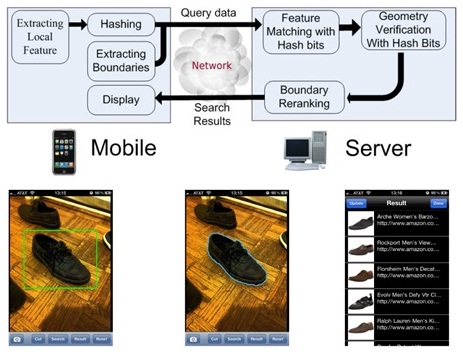 |
|
Mobile Product Search with Bag of Hash Bits and Boundary Reranking. Junfeng He, Jinyuan Feng, Xianglong Liu, Tao Cheng, Tai-Hsu Lin, Hyunjin Chung, Shih-Fu Chang In IEEE International Conference on Computer Vision and Pattern Recognition (CVPR) Providence, Rhode Island June, 2012 [pdf][ poster ] |
| |
In this work, we propose a novel mobile visual search system based on ”Bag of Hash Bits” (BoHB), in which each local feature is encoded to a very small number of hash bits, instead of quantized to visual words, and the whole image is represented as bag of hash bits. We also incorporate a boundary feature in the reranking step to describe the object shapes, complementing the local features that are usually used to characterize the local details.
|
|
|
|
|
|
| |
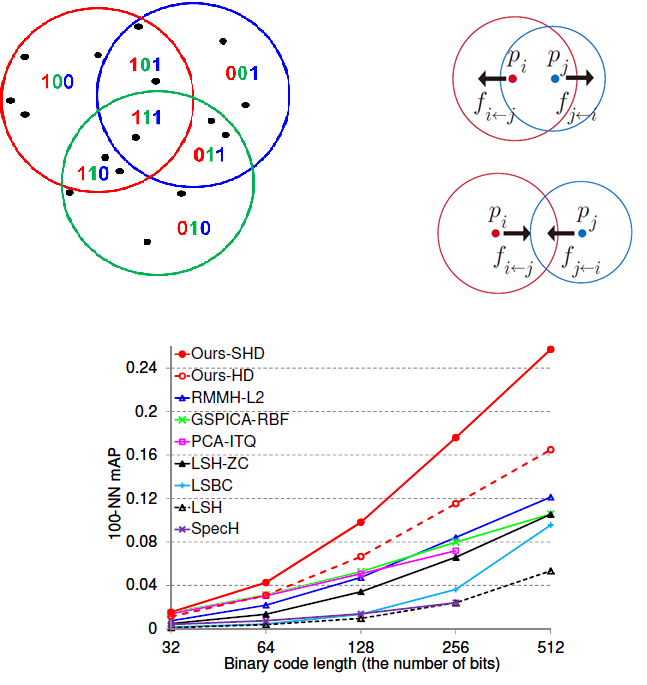 |
|
Spherical Hashing. Jae-Pil Heo, YoungWoon Lee, Junfeng He, Shih-Fu Chang, Sung-eui Yoon In IEEE International Conference on Computer Vision and Pattern Recognition (CVPR) Providence, Rhode Island June, 2012 [pdf] |
| |
In this paper we propose a novel hashing function based on hypershpere, Spherical Hashing, to map more spatially coherent data points into the same binary code compared to hyperplane based hashing functions.The excellent results confirm the unique merits of the proposed idea in using hyperspheres to encode proximity regions in high dimensional spaces.
|
|
|
|
|
|
| |
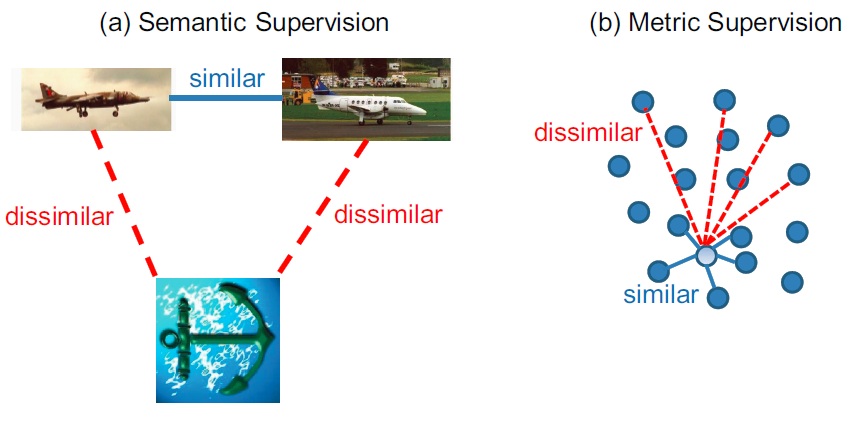 |
|
Supervised Hashing with Kernels. Wei Liu, Jun Wang, Rongrong Ji, Yu-Gang Jiang, Shih-Fu Chang In IEEE International Conference on Computer Vision and Pattern Recognition (CVPR) Providence, Rhode Island June, 2012 (oral presentation) [pdf][ slide ][ code ] |
| |
We showed the supervised information such as semantic label consistence and metric neighborhood between pairs of points can be utilized to design robust compact hash codes. Our supervised hashing technique is unique in using code inner product rather than Hamming distance and incorporating kernel-based models in the optimization process.
|
|
|
|
|
|
| |
 |
|
Joint Audio-Visual Bi-Modal Codewords for Video Event Detection. Guangnan Ye, I-Hong Jhuo, Dong Liu, Yu-Gang Jiang, D.T. Lee, Shih-Fu Chang In ACM International Conference on Multimedia Retrieval (ICMR) Hong Kong June, 2012 [pdf][Poster] |
| |
We develop a joint audio-visual bi-modal representation to discover strong audio-visual joint patterns in videos for detecting multimedia events.
|
|
|
|
|
|
| |
.jpg) |
|
Compact Hashing for Mixed Image-Keyword Query over Multi-Label Images. Xianglong Liu, Yadong Mu, Bo Lang, Shih-Fu Chang In ACM International Conference on Multimedia Retrieval (ICMR) Hong Kong June, 2012 (Oral presentation) [pdf][slides] |
| |
This paper addresses a new problem of query-adaptive hashing. Our work is distinct from others by two unique features: 1) mixed image-keyword query, namely each query is comprised of an examplar image and several descriptive keywords, and 2) each data point is associated with multiple labels. We propose a boosting style algorithm for effectively learning compact hash codes under above settings.
|
|
|
|
|
|
| |
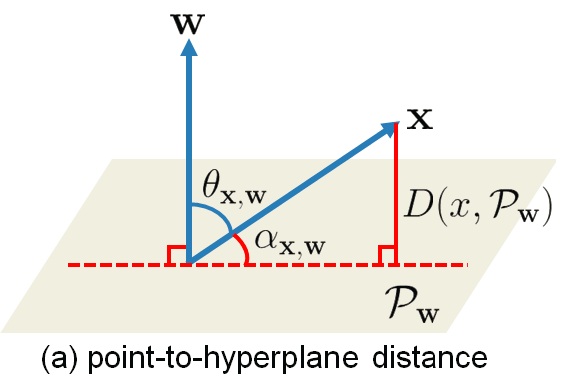 |
|
Compact Hyperplane Hashing with Bilinear Functions. Wei Liu, Jun Wang, Yadong Mu, Sanjiv Kumar, Shih-Fu Chang In International Conference on Machine Learning (ICML) Edinburgh, Scotland June, 2012 [pdf][ poster ][ slide ] |
| |
Hyperplane hashing aims at rapidly searching nearest points to a hyperplane, and has shown major impact in scaling up active learning with SVMs. We developed a projection technique based on a novel bilinear form, with a proven higher collision probability than all prior results. We further developed methods to learn the bilinear functions directly from the data.
|
|
|
|
|
|
| |
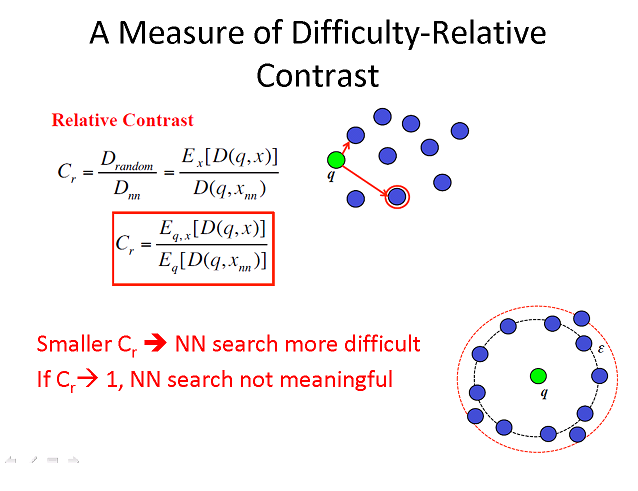 |
|
On the Difficulty of Nearest Neighbor Search. Junfeng He, Sanjiv Kumar, Shih-Fu Chang In International Conference on Machine Learning (ICML) Edinburgh, Scotland June, 2012 [pdf][supplementary material][poster] |
| |
How difficult is (approximate) nearest neighbor search in a given data set? And which data properties affect the difficulty of nearest neighbor search and how?This paper introduces the first concrete measure called Relative Contrast that can be used to evaluate the influence of several crucial data characteristics such as dimensionality, sparsity, and database size simultaneously in arbitrary normed metric spaces.
|
|
|
|
|





.gif)







.jpg)




.jpg)

